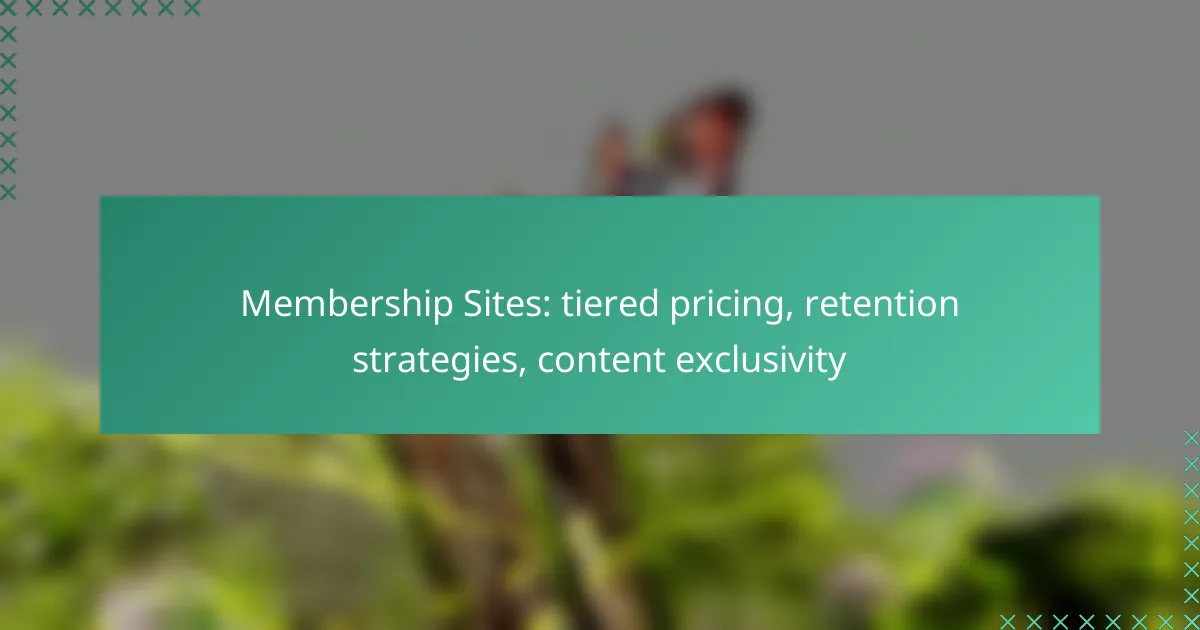Membership sites can significantly benefit from implementing tiered pricing strategies that cater to diverse user needs, enhancing both acquisition and retention. By fostering a sense of community and providing exclusive, high-quality content, these platforms can create engaging experiences that encourage members to remain active and invested over time.

What are effective tiered pricing strategies for membership sites in Canada?
Effective tiered pricing strategies for membership sites in Canada involve offering multiple pricing levels that cater to different user needs and preferences. This approach can enhance user acquisition, retention, and overall satisfaction by providing options that align with varying budgets and usage patterns.
Freemium model
The freemium model allows users to access basic features for free while offering premium features at a cost. This strategy can attract a larger audience, as potential members can experience the value of the service without any initial investment. However, it’s crucial to ensure that the free version is compelling enough to encourage upgrades.
To implement this model effectively, consider offering a limited set of features or usage caps on the free tier. This creates a natural incentive for users to transition to a paid plan as their needs grow.
Subscription tiers
Subscription tiers involve creating different levels of membership, each with its own set of features and pricing. For example, a basic tier might offer limited content access, while a premium tier includes exclusive resources, community features, or personalized support. This structure allows users to choose a plan that best fits their needs and budget.
When designing subscription tiers, ensure that the value increases significantly with each level. Clear communication of the benefits associated with higher tiers can drive conversions and reduce churn.
Usage-based pricing
Usage-based pricing charges members based on their actual usage of the service, making it a flexible option for users who may not need consistent access. This model is particularly appealing for services that have variable demand, allowing members to pay only for what they use.
To implement usage-based pricing, establish clear metrics for measuring usage, such as the number of downloads or hours of access. This transparency helps build trust and ensures users feel they are getting fair value for their payments.
Annual vs monthly billing
Offering both annual and monthly billing options can cater to different financial preferences among users. Monthly billing provides flexibility, while annual billing often comes with a discount, encouraging long-term commitments. This can lead to improved cash flow and reduced churn rates.
When presenting these options, clearly highlight the savings associated with annual billing to incentivize users to commit for a longer period. Consider offering a trial period for annual plans to alleviate concerns about upfront costs.
Discounts for long-term commitments
Discounts for long-term commitments can be an effective strategy to increase retention and secure revenue. By offering a lower rate for users who commit to a longer subscription period, you can encourage members to stay engaged with your platform.
Common practices include providing a percentage discount for annual subscriptions or offering exclusive content for long-term members. Ensure that the value of the discount is clear and compelling to motivate users to opt for longer commitments.

How can membership sites improve retention rates?
Membership sites can enhance retention rates by fostering a sense of community, providing regular content updates, and offering personalized communication. These strategies create a more engaging experience, encouraging members to stay longer and participate actively.
Engaging community features
Incorporating community features such as forums, discussion boards, or social media groups can significantly boost member engagement. These platforms allow members to connect, share experiences, and support each other, fostering loyalty and a sense of belonging.
Consider implementing features like member spotlights or user-generated content to encourage participation. Regularly highlight contributions from members to make them feel valued and invested in the community.
Regular content updates
Consistently updating content keeps members interested and returning for more. This can include new articles, videos, or tutorials that align with their interests and needs. Aim for a schedule that balances quality and quantity, such as weekly or bi-weekly updates.
Offering a mix of content types can cater to different preferences. For example, consider incorporating live Q&A sessions, webinars, or downloadable resources to maintain variety and engagement.
Personalized communication
Personalized communication can significantly enhance member retention by making individuals feel recognized and valued. Use data to tailor messages based on member behavior, preferences, and engagement levels, such as sending targeted emails or notifications about relevant content.
Regularly solicit feedback through surveys or direct messages to understand member needs better. This not only shows that you care but also helps you adjust your offerings to meet their expectations.
Exclusive member events
Hosting exclusive events, such as webinars, workshops, or meet-and-greets, can create a sense of exclusivity and belonging among members. These events provide opportunities for networking and learning, enhancing the overall value of membership.
Consider varying the format and frequency of events to keep them fresh and appealing. For example, monthly webinars followed by quarterly in-person gatherings can cater to diverse member preferences and schedules.

What types of content exclusivity can enhance membership value?
Content exclusivity is a key factor in increasing the perceived value of membership sites. By offering unique and high-quality content, you can attract and retain members who are willing to pay for access to resources they can’t find elsewhere.
Premium articles and guides
Premium articles and guides provide in-depth insights and expert knowledge that are not available to non-members. These resources can cover niche topics, industry trends, or specialized skills, making them highly valuable to your audience.
To maximize their impact, consider regularly updating these articles and guides to reflect the latest information and best practices. Offering downloadable formats can also enhance usability and appeal.
Webinars and live Q&A sessions
Webinars and live Q&A sessions create an interactive experience that fosters community engagement. Members appreciate the opportunity to ask questions and receive real-time feedback from experts or industry leaders.
Schedule these events at convenient times for your target audience and promote them well in advance. Recordings should be made available afterward for members who cannot attend live, adding further value to the membership.
Exclusive video content
Exclusive video content, such as tutorials, interviews, or behind-the-scenes footage, can significantly enhance the membership experience. Videos are engaging and can convey complex information more effectively than text alone.
Consider varying the format of your video content, including short clips for quick tips and longer, more detailed presentations. Ensure that videos are easily accessible on multiple devices to cater to different viewing preferences.
Member-only forums
Member-only forums provide a platform for members to connect, share experiences, and seek advice from one another. This sense of community can increase member retention and satisfaction.
To encourage participation, establish clear guidelines for engagement and consider appointing moderators to facilitate discussions. Regularly highlight valuable contributions and create themed discussion threads to keep the conversation flowing.

What are the key metrics for measuring membership site success?
Key metrics for measuring membership site success include churn rate, customer lifetime value, engagement metrics, and revenue growth. These metrics provide insights into member retention, profitability, user interaction, and overall financial health.
Churn rate
Churn rate measures the percentage of members who cancel their subscriptions over a specific period. A high churn rate indicates issues with member satisfaction or value perception, while a low churn rate suggests effective retention strategies.
To calculate churn rate, divide the number of lost members during a period by the total number of members at the start of that period, then multiply by 100. For example, if you start with 100 members and lose 5, your churn rate is 5%.
Customer lifetime value
Customer lifetime value (CLV) estimates the total revenue a member generates during their relationship with your site. Understanding CLV helps in determining how much to invest in acquiring and retaining members.
To calculate CLV, multiply the average revenue per user by the average customer lifespan. For instance, if a member pays $10 monthly and stays for 12 months, their CLV is $120. Aim for a CLV that significantly exceeds your acquisition costs.
Engagement metrics
Engagement metrics track how actively members interact with your content and community. High engagement often correlates with lower churn rates and increased member satisfaction.
Common engagement metrics include login frequency, content consumption rates, and participation in discussions or events. For example, if members log in at least once a week and participate in forums, they are likely more invested in your site.
Revenue growth
Revenue growth measures the increase in income generated from membership fees over time. This metric is crucial for assessing the financial viability and scalability of your membership site.
To analyze revenue growth, compare income over different periods, such as quarterly or annually. A consistent growth rate of 10-20% is often considered healthy for membership sites. Focus on strategies like tiered pricing and upselling to boost revenue effectively.

What frameworks can help in selecting the right pricing model?
Choosing the right pricing model for a membership site involves frameworks that assess market demand, competitor strategies, and customer preferences. Effective frameworks can guide you in establishing tiered pricing, enhancing retention strategies, and ensuring content exclusivity.
Market research analysis
Conducting market research is essential for understanding your target audience’s willingness to pay and their preferences regarding membership benefits. Surveys, focus groups, and online analytics can provide insights into what potential members value most, such as exclusive content or community access.
Utilize tools like Google Trends or social media analytics to gauge interest in specific topics or features. This data can inform your pricing tiers, helping you align them with what customers are seeking. For instance, if users show high interest in premium content, consider offering a higher-priced tier that includes this exclusive access.
Competitor pricing comparison
Analyzing competitor pricing is crucial to positioning your membership site effectively. Review the pricing structures of similar sites to identify common tiers and features offered. This can help you determine where your offerings can stand out or align with market expectations.
Consider creating a comparison table that outlines competitor pricing, features, and membership benefits. This visual can help you identify gaps in the market. For example, if competitors charge around $10 to $30 per month for basic access, you might choose to offer a competitive price point or additional features to attract members.
